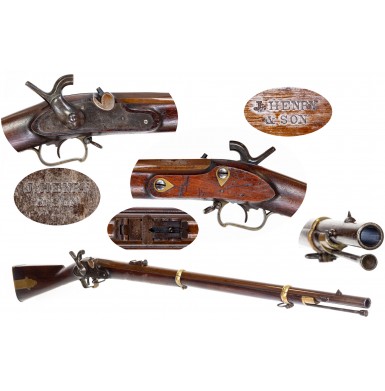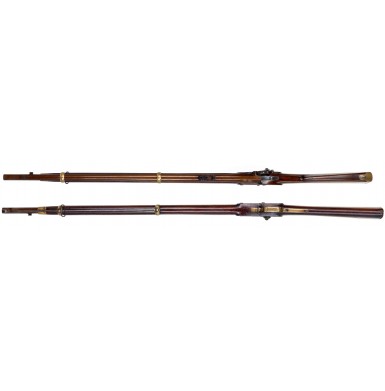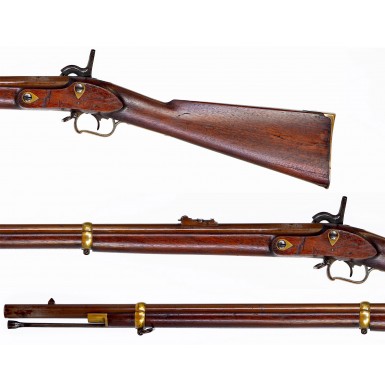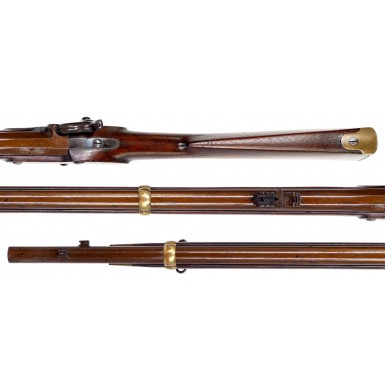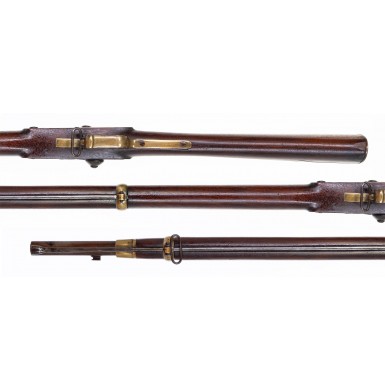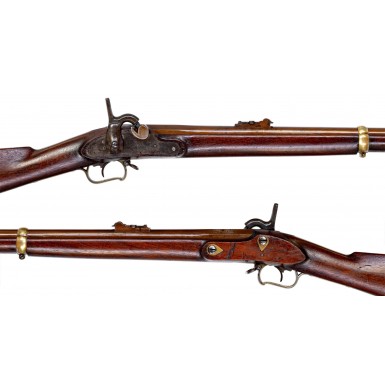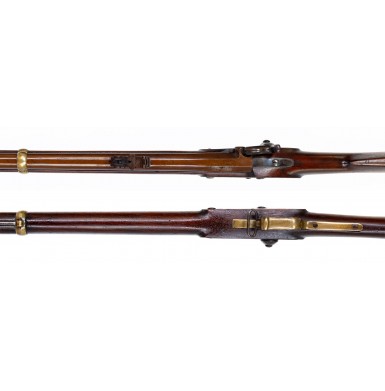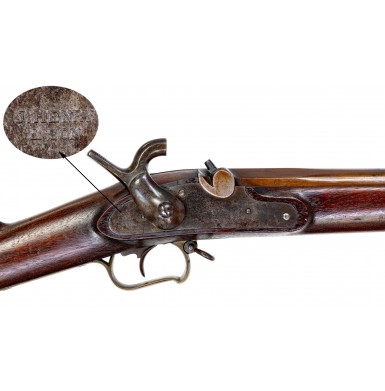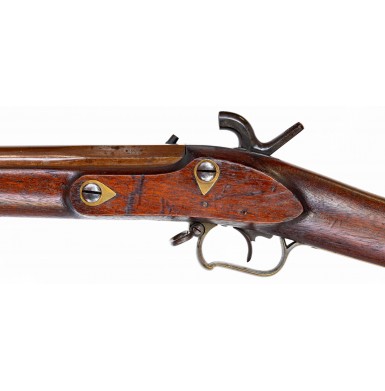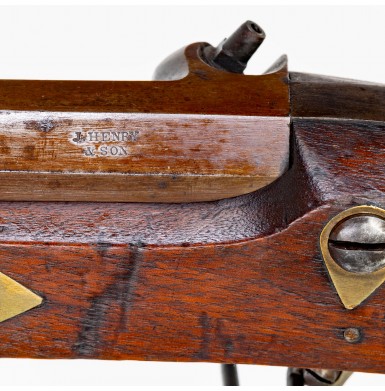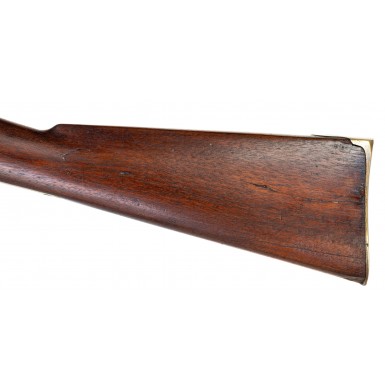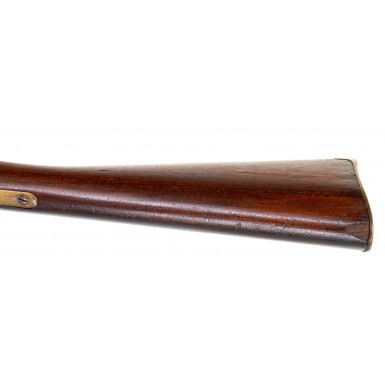Fine and Scarce J Henry & Son Saber Rifle for the Pennsylvania Home Guard
- Product Code: FLA-C179
- Availability: In Stock
-
$4,995.00
The gunmaking firm that would become J. Henry & Son was initially established by William Henry in Lancaster, PA, prior to the French & Indian War. During that era Henry produced arms for the use of British colonial militiamen, and even took the field himself as an armorer during the campaign to recapture Fort Duquesne during 1758. In the years after the French & Indian War, he served as a delegate to the Continental Congress. By about 1760 he had left the gun trade and become a successful Lancaster based iron monger, but his son John Joseph Henry took up the family gunmaking business sometime around 1775 and the firm continued operation under his leadership until 1811, when John Joseph Henry II took over. During the early 1800s, the firm relocated to Boulton, PA. The firm became known generally as the Boulton Gun Works (some references spell it “Bolton”). After John Joseph’s death, his son James took over, and in 1859 James’ son Granville joined the firm and the name was changed to “J. Henry & Son”.
During their nearly six decades in business prior to the name change, the Henry family had produced guns for the new United States government, for the states of Pennsylvania, Delaware and Maryland and numerous fur trading companies engaged in commerce with the many American Indian tribes. They also worked as manufacturers for other gunmakers and retailers like Philip S. Justice of Philadelphia, selling that firm both completed arms and parts to manufacture arms from. It is also likely that the Henry firm provided gun parts to other local Pennsylvania gunmakers like John Krider and possibly Henry Leman.
With the coming of the American Civil War, and the calling for 100,000 volunteers to suppress the rebellion, (not to mention the calling out of Pennsylvania militia units for the defense of the state) Henry looked to produce military arms to cash in on the need for guns. He produced two patterns of military style percussion muzzleloading rifles and a cadet musket. The rifles were offered with either a socket or a saber bayonet and were known respectively in the Henry company records as “Minié Rifles” or “Saber Rifles”. Both patterns of arms were brass mounted rifles with 35” barrels in .58 caliber. Most had a unique “recurved” triggerguard that is commonly associated with the arms made (or sold) by both Henry and P.S. Justice. It appears that much of the brass furniture was probably obtained from Bernard Leman of Philadelphia in 1861. It is not clear if both Henry and Justice purchased brass furniture from him or if Justice acquired the parts from Henry. Both patterns of Henry rifle also included a brass patchbox that is also associated with arms made by Justice and Krider. It appears that these patch boxes were left over parts purchased from the Sharps Firearms Manufacturing Company of Philadelphia. In 1859 Sharps had transitioned from brass mountings to iron mountings, and apparently a large number of brass patchboxes in varying states of manufacture were sold as unneeded surplus.
The best research suggests that the 285 “Minié Rifles” produced by Henry during the summer of 1861 were sold almost entirely to Justice, who sold them to the US government to help satisfy his contract for rifles. However, Henry sold 40 of these rifles to the Bethlehem Home Guard in August of 1861. In addition, Henry produced some 952 “Saber Rifles”during the summer of 1861, most of which (876) were also sold to Justice, with deliveries starting in September of that year. However, 70 were sold by Henry to the Catasanga Home Guard in October and November, and another 6 were used as sample rifles in an attempt to obtain other military contracts.
Offered here is a FINE condition example of one of the very scarce J. Henry & Son Saber Rifles, and I believe that it was one of the 70 “Home Guard” guns. The 876 guns sold to Justice were Justice marked (either by Henry or Justice), and only the 70 “Home Guard” saber rifles and the 6 “sample rifles” were marked with the Henry name. This rifle is clearly marked in two horizontal lines:
J. HENRY
& SON
on the left angled barrel flat near the breech and in two vertical lines on the lock plate, behind the hammer. The standard finish for the J. HENRY & SON Saber Rifle was a color case hardened lock and browned barrel, with all small iron parts blued and the brass mountings left bright. This example is so finished. The gun is assembly numbered 3 and this number is stamped inside the lock, on most of the lock parts (including the hammer’s neck), under the barrel, on the rear of the screw lugs for the barrel bands, on the necks of the lock and breech plug tang screw and weakly in the barrel channel. The right side of the muzzle of the rifle is numbered 440 to match the gun to the Collins & Company saber bayonet that was fit to this rifle.
As noted, the rifle is in about FINE overall condition, and appears to be 100% complete, correct, and original. The 35” octagon to round barrel is full length and retains about 85% coverage of its thinning and fading browned finish. The brown would only rate about 30%-40% in terms of how much of the amount applied when it was manufactured remains, but despite the thinning, fading and light wear, it still retains most of the metal coverage, just not nearly at thickly as when it was new. Like a couple of other high condition browned Henry Rifles that I have had the opportunity to examine and disassemble, the barrel was not fully browned, but rather appears to have been “brush browned” and the finish was not applied to the bottoms of the barrels, except near the muzzle and to about 1” or so behind the saber bayonet lug. Traces of brown that has run or dripped under the barrel are noted, and as is also common on these guns the finishing work on the bottom of the barrels is not fantastic. It seems Henry was applying some of the cost cutting techniques the family had probably used back to the days of making Indian Trade guns. The barrel shows freckled patches of oxidized age discoloration scattered along its the length, as well as some lightly scattered patches minor roughness and very light pitting. This is most noticeable at the face of the muzzle and some minor areas around the breech. The four-groove bore of the rifle is in FINE condition and is mostly bright throughout. The bore retains very crisp rifling with the grooves about twice as wide as the lands and shows only some scattered oxidation and some lightly scattered pitting along its length. The original adjustable ladder rear sight is present on the top of the barrel, 6 1/8” from the breech. The side walls and ladder are not numbered or regulated, which is typical of these rifles. The original peaked rifle-style front sight is in place near the muzzle, as is the original saber bayonet-mounting lug. The original and correct ramrod is present in the channel under the barrel, and is full length, with fine threads on the end. The lock of the rifle is in FINE mechanical condition and operates crisply on all positions. The lock has a mottled gray patina that hints at the original case colored finish, which has faded and dulled to its current appearance. The original percussion cone is in place in the bolster and remains crisp with much of its blue intact. The brass furniture has a lovely, mellow golden patina. The patchbox opens and closes smoothly and the brass triggerguard and upper barrel band both retain what appears to be the original sling swivels. The stock of the rifle is in FINE condition as well and remains crisp with a feathery grain. The stock shows no indication of having been sanded, and the sharp edges remain sharp as they should be, with good definition and fine wood to metal fit throughout. There are the usual bumps, dings, and minor surface mars from handling, use and storage over more than 150 years, but nothing serious or abusive. There are a couple of grain cracks on both sides of the butt that appear to be the result of drying. These are tight and do not appear to be structural. Interestingly Justice stocks often have these same cracks, which are attributed to his use of wood that was not fully seasoned. The stock also has a small amount of cast off or a minor bend that is visible in the photos taken from above and below. This could be the result of unseasoned wood as well. A small chip is missing from the toe of the stock and this is clearly shown in the photos.
Overall, this is an extremely nice and rather scarce example of a J. Henry & Son Saber Rifle in very crisp and original condition. With only 76 of the total production of these rifles being sold or delivered by Henry to someone other than PS Justice, and with the rifle being Henry marked instead of Justice marked, it is a very rare gun. Even including the 876 delivered to Justice, less than 1,000 of these rifles were produced. This is a great rifle to add to a collection of Pennsylvania made military arms, Civil War secondary martial rifles or just a collection of J. Henry firearms. This is a fine condition, very crisp and complete example of a rather scarce Civil War rifle that you will be very glad to add to your collection.
Tags: Fine, and, Scarce, J, Henry, &, Son, Saber, Rifle, for, the, Pennsylvania, Home, Guard

